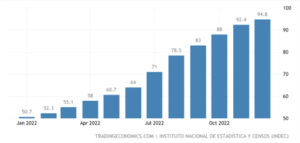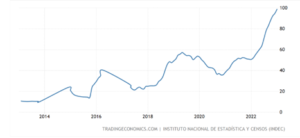
By Marie Chevoleau, Student at McGill University
When visiting the country last December, I realized how cash is king in Argentina, where large parts of the economy are still informal.
With record inflation in 2022, Argentina’s price rise is still strong in 2023. Argentines’ wallets are becoming heavy and filled with low-value notes. If you go to an office to withdraw the equivalent of €100 in Argentine pesos, don’t be surprised to leave with a bundle of a hundred notes. Thus, the new 2,000-peso banknote will be equivalent to only 10.38 US dollars at the official exchange rate value as of the 18th of February, 2023. It is important to note that the banknote value is 50% less if we consider the exchange rate used by the population in unofficial street exchanges. That is about one US dollar for 360 pesos, which will also become the largest denomination in circulation and probably help lighten the wallets of Argentines.
The central bank of Argentina announced the news on the second of February. This measure results from a country plagued by galloping inflation and a constant depreciation of its national currency. Argentina reported inflation of almost 95% at the year-ending of 2022, the highest rate in 32 years. However, the December index confirms a relative deceleration in recent months.

Argentina’s inflation rate in 2022
Image: Trading economics
Source: https://tradingeconomics.com/argentina/inflation-cpi
In January 2023, the inflation index reached 6%. This rate jeopardizes Argentine’s Minister of Economy, Massa, who previously forecasted that inflation would be around 3% monthly by April.
Inflation is part of Argentina’s history
Reaching an inflation rate of 95% is not an exceptional event for the country. Indeed, inflation in Argentina has been much higher in the past. In 1975, The New York Times, in its article “Inflation: Argentine Way of Life.” already stated the long life of inflation in Argentina and its accentuation in 1975, but also shared the opinion of economists and businesses that the bubble will eventually burst. However, following this, from 1975 to 1990, the annual rate averaged 300%. Thus, the price level doubled every few months on average. In 1989, according to the World Economic Forum information, prices rose at an explosive annual rate of more than 1,000% before inflation was finally controlled. From 2014 onwards, the inflation rate never fell below 10% and had impressive jumps, such as in 2016, when it jumped back up to 40%, propelled by removing distortionary price subsidies that had previously been used to disguise the true inflation rate.

Ten years inflation rate in Argentina
Image: Trading economics
https://tradingeconomics.com/argentina/inflation-cpi
Hence, the inflation rate observed for 2022 is not an isolated incident but a repetition of a long-term pattern. As observed by The New York Times, as far as we remember, inflation has effectively always been a way of life in Argentina. Different strategies to counter inflation have been implemented, including the government’s monetary policies, underestimating the inflation rate, or implementing price subsidies. One explanation is that high inflation rates remain in the public’s memory and have long-lasting adverse psychological effects that are difficult to remove.

The US Dollar (USD) to Argentine Peso (ARS) Exchange Rate in Monthly Averages from 2005 to 2019
Image: FRED Database, Federal Reserve Bank of St. Louis
The inflation rate freezes the economy
Because the market’s interest rates rise to compensate for high inflation, even the government must now pay a very high-interest rate to borrow in pesos for short or long periods. For instance, the Argentina 10Y Government Bond has an estimated huge 49.680% yield. The actual central bank rate of Argentina was 75.00% in September 2022. The government is thus trying to reduce the amount of money in circulation to reduce inflation and stabilize the economy. Still, once again, the long-lasting instability of the inflation rate makes it very difficult to reverse.
More specifically, lenders are unwilling to provide long-term credit at fixed interest rates because a jump in inflation would destroy the value of their bonds and loans. On the other hand, households and businesses are reluctant to finance long-term investments with short-term or variable-interest-rate loans because a jump in inflation would cause their interest payments to rise sharply. Indeed, Argentina’s history of extreme and unpredictable inflation has caused the mortgage market to be virtually non-existent, as households cannot acquire mortgages due to the associated risks. Additionally, businesses are unwilling to take out loans due to fears that drastic changes in the peso’s value will cause them to become insolvent. Finally, the life insurance industry has been similarly devastated, as buyers are unwilling to purchase policies with current pesos due to the uncertainty of what the currency will be worth.
This situation leads to more and more protests of workers demanding salary increases and better working conditions amid rising inflation. However, the government has installed price caps on many goods to slow inflation. Prices could only increase by a maximum of 3.2% per month between February to June. Hopefully, these price caps will help maintain inflation for 2023.

Marie Chevoleau
Marie is a French student at the IESEG School of Management. This year, she is studying at McGill University in Montreal. Marie is driven by challenges and new life experiences. Interested in strategy, history, and finance, Marie is also interested in people and would like to use her skills to improve working environments, especially for women. Her goal is to pursue a career in the corporate finance field to put her mathematical and analytical skills to good use while closely interacting with businesses and helping them with their different needs.
I was very happy to search out this web-site.I wished to thanks on your time for this glorious read!! I undoubtedly having fun with each little bit of it and I’ve you bookmarked to check out new stuff you weblog post.